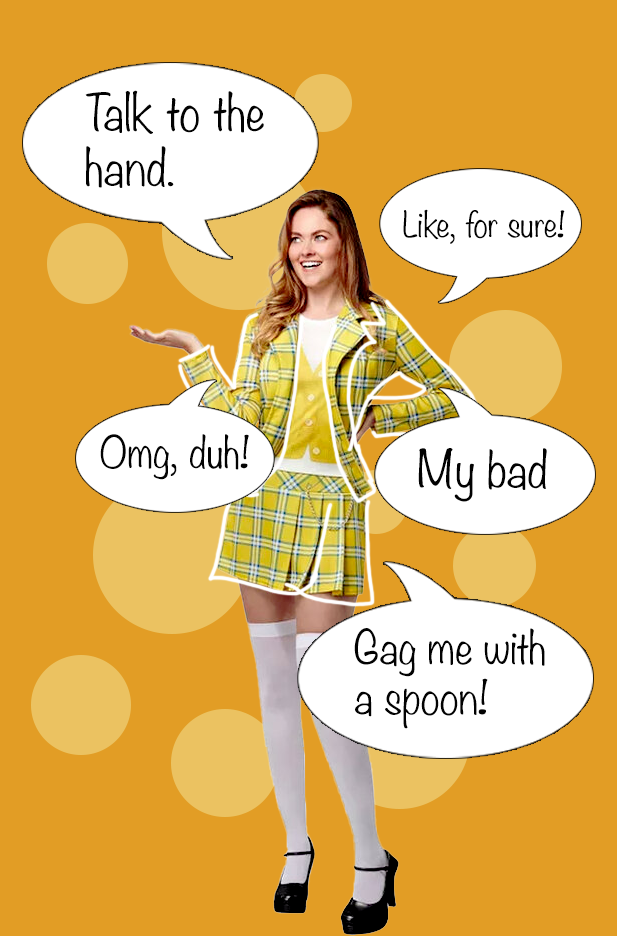The halls of a Beverly Hills high school buzz with designer fashion and teenage drama. At the center of it all is Cher Horowitz, effortlessly striding through in a perfectly coordinated yellow plaid ensemble.
Cher Horowitz walks through the halls of her Beverly Hills high school. Effortlessly stylish in plaid and with a flick of her hand, she dismisses a suitor—“Ugh, as if!”
Later, driving her white Jeep, she exclaims, “I totally paused!” Every word drips with that unmistakable Valley Girl rhythm: elongated vowels, breathy tones and a heavy dose of “like.”
It’s not just a way of speaking — it’s an identity, both iconic and ridiculed. This way of speaking is commonly known as the Valley Girl accent.
Although the accent existed before the 1980s it gained widespread recognition after Frank Zappa’s 1982 song “Valley Girl,” featuring his daughter Moon Unit’s slang and speech style, including frequent use of the word “like.’”
The Oxford Learner’s Dictionary defines the Valley Girl as “a rich girl who is thought to only be interested in things like fashion, shopping and physical appearance,” a stereotype associated with young people in the San Fernando Valley.
Movies like “Valley Girl” (1983) and “Clueless” (1995), reinforced the negative perception of the accent.
Jordan Moore, a graduating senior at Reidsville High School in North Carolina, says he mostly hears the accent from Californians.
He doesn’t live in the San Fernando Valley, so he finds it easy to identify.
“In my mind, it’s less about how you speak and more about what you say and the greater vibe of your remarks,” Moore said. “There is a sort of inflection, in my experience, toward the end of a sentence, almost like a pitch up or a holding of words.”
Senior Shayir Blanco also notices similar speech patterns.
“I think the Valley girl accent is easy to recognize,” he said. “They tend to elongate their words, talk slower.”
Senior Olivia Yoshizaki agrees with that idea and adds that it normally also includes people with a certain tone when speaking.
“To me, a Valley Girl Accent is mainly characterized by a nasally voice, breathiness and a repetition of filler words,” she said.
Yoshizaki shares that she has been told she has a “Californian Accent,” the Valley Girl being a subsection of it.
“People have told me that I have an accent before, not a Valley Girl one, but a Californian one,” she said.
According to Clarissa Wei, a journalist at the Los Angeles Times and self-identified “Valley Girl,” notes that features of the accent — like the overuse of “like,” “totally” and “whatever” — are not exclusive to women and were in use even before the 1980s.
Still, media portrayals of young women using these words have reinforced the Valley girl stereotype.
Speakers with a Valley Girl accent are often perceived as superficial and materialistic, largely due to film portrayals.
Yoshizaki says that the stigma circling those with a Valley girl accent are very prevalent.
“I think the biggest misconceptions are that they are “dumb” or “fake,” she said.
Valley Girl speakers are not generally perceived as being intelligent, a view Blanco acknowledges.
“I do think there’s a stereotype,” he said. “They are perceived typically to be slow; they aren’t the smartest.”
She also says that the accent includes a fluctuation in voice and speed of talking.
“There are definitely differences between Californians and other parts of the country like New Yorkers or Southerners,” she said. “While people on the east coast talk faster and more directly, we speak slower and sometimes raise the pitch of the end of our sentences.”
Moore believes this stereotype is an overgeneralization influenced by films.
“There is definitely a stereotype surrounding the idea of a Valley Girl,” he said. “The name even implies that there should be a stereotype. Valley Girl denotes a specific region, a specific person and that’s not representative of who has an accent.”
This perception of the Valley Girl accent as artificial or exaggerated has contributed to broader stereotypes about California culture.
Because it’s common in Southern California and especially here in the San Fernando Valley, locals often view the accent as normal, however, non-Californians may easily notice it.
“As someone from North Carolina, immediately associate it with the younger generation — young women usually,” Moore says.
The Valley Girl accent, once tied to stereotypes of materialism and shallow youth, has evolved over time. While films like “Clueless” helped define its pop culture status, the accent now reflects a broader Californian identity, blending with modern slang and internet culture.
Whether embraced or dismissed, it remains an unmistakable part of Southern California’s linguistic legacy, continuing to shape how people speak today.
This article originally appeared in the Summer 2025 print edition.




